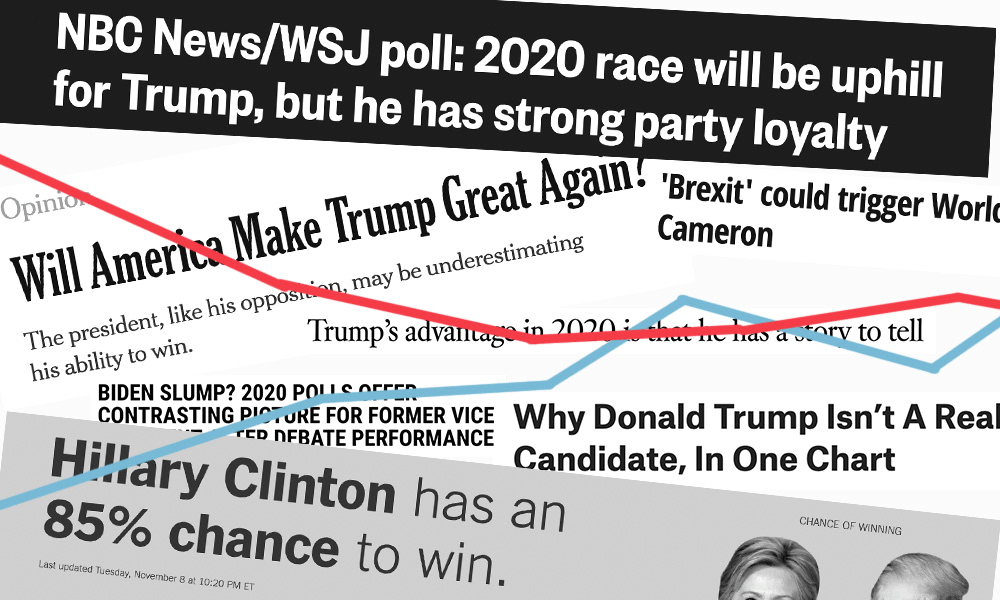Media Projections and Trump’s Election: A Self-Defeating Prophecy?

As these lines are being written, the 2020 U.S. elections are more than a year away, and a clear Democratic presidential nominee has yet to emerge. And yet, projections about President Trump’s chances of re-election are already flowing through multiple channels, from op-eds and polls in the news media to various prediction and betting markets. At this early stage, the accuracy of these projections is not necessarily the issue at stake. Rather, we should ask ourselves whether such projections may already be affecting the very future that they are attempting to predict.
In the run-up to the 2016 U.S. presidential elections, the media were replete with projections about Donald Trump’s chances of becoming the next president and the implications of such an outcome. Pundits and journalists ventured various projections through the news media while mediating and interacting with the forecasts of data analysts, scientists, and politicians. A dominant line of predictions suggested a low probability of a Trump victory, ranging from FiveThirtyEight’s analysis of “Why Donald Trump Isn’t a Real Candidate?” at the beginning of the Republican primary season to final assessments in major news outlets, such as the New York Times’s prediction that “Hillary Clinton Has an 85% Chance to Win” or the Washington Post’s story, “A Comprehensive Average of Election Forecasts Points to a Decisive Clinton Victory.”

Following the results of both the Republican primaries and the presidential elections, the dominant public discourse on projections focused on the purported failure of experts and the media to predict Trump’s election. A similar discourse followed the surprising results of the Brexit referendum in the U.K. a couple of months earlier (June 2016). In both cases, various explanations were offered for why experts and the media did not get it right: surveys and statistics were used instead of going out to actually speak with people and understand their worldview; the samples were not representative; or their elitist tendencies or political views blinded them and shaped their interpretations. Others have argued that the whole prediction enterprise is doomed to begin with and that journalists should focus instead on their primary mission of reporting on that which has already happened.
These explanations and debates have illuminated a host of problems in the media’s attempt to project the future, and they represent different methodological, theoretical, and normative perspectives. They also signify different approaches to the feasibility of political predictions, ranging from the claim that political realities are inherently unpredictable (as suggested by Nassim Taleb’s notion of The Black Swan) to the view that there are ways to achieve more accurate political predictions by using systematic probabilistic thinking that overcomes the biases of intuitive human judgments (Philip Tetlock’s work on Superforecasting is most notable in this regard, as well as Nate Silver’s approach). Within the latter, some news outlets and data journalists arguably did a better job than others in predicting the results of the U.S. 2016 elections.
All types of projections, from doomsday scenarios to detailed statistical predictions, can play an important role in shaping the expectations, fears, and hopes of millions of potential voters.
However, all of these explanations and debates have assessed the functioning of the media from the perspective of the correspondence between projected and actual reality, namely, the success or failure to accurately predict the future. But what about other functions that media projections played in these cases, and projections other than polling numbers and other statistical predictions? Is it possible that mediated projections also intervened in the projected reality rather than just attempting, and often failing, to accurately reflect it?
Media Projections as a Form of Intervention
As we know from psychological theory and from daily experience, when we make projections about our own lives, we are usually not engaged in a scientific exercise of getting it right. Rather, we construct future scenarios as a way of orienting and conducting ourselves in the world: We prepare for the projected future and sometimes act in order to help bring about a desirable future or prevent a scary one.
Societies likewise prepare for the future and try to shape it through projections. For instance, as argued by the new media scholar Richard Grusin, the intense premediation of future scenarios following the traumatic 9/11 attacks was an attempt to avoid a similar future shock. Furthermore, projections about the outcomes and implications of significant events, be they the U.S. presidential elections, the Brexit referendum, or the war in Syria, can mobilize or demobilize multiple actors. If a predicted outcome is undesirable, it may trigger attempts to avert it, dodge its impact, or take preparatory measures (e.g., protest, arm, vote differently than planned). Conversely, a desirable projection may arouse people’s hopes of benefitting from the predicted event or even motivate them to help bring it about (e.g., by donating or volunteering).
When we make projections about our own lives, we are usually not engaged in a scientific exercise of getting it right.
Projections are thus a form of intervention. At the collective level, such interventions unfold primarily within and through the media, with the media serving as both a central venue where projections are negotiated and as central actors in their own right. Some future-oriented media interventions are direct and blunt, as exhibited, for instance, by the extravagant utopias and doomsday scenarios on the front pages of the U.K. tabloids before the Brexit referendum. For example, on the day of the referendum, evocative front pages carrying headlines such as The Sun’s “Independence Day: Britain’s Resurgence” (accompanied by an image of a globe and a glowing sun above Britain) and the Daily Mirror’s “Don’t take a leap into the dark…vote REMAIN today” (accompanied by an image of a black hole) were aimed at mobilizing voters in the opposing directions.

Such interventionist practices are generally not found on the front pages of U.S. newspapers, but attempts at direct media interventions through projections can be identified in opinion columns, the predictions of cable pundits, and satirical interventions. For example, a mock front page created by The Boston Globe during the U.S. presidential campaign in April 2016 carried the date of April 9, 2017. Using snippets of Trump’s own words, The Boston Globe envisioned how the front page of the newspaper would look under a Trump presidency. The lead story, “Deportations to Begin,” reported on a televised address by President Trump in which he called on Congress to fund a “massive deportation force.” The other headlines included: “Markets sink as trade war looms,” “US soldiers refuse orders to kill ISIS families,” and “New libel law targets ‘absolute scum’ in press.” While this satirical front page was aimed at preventing this envisioned future (as The Boston Globe tweeted, “the front page we hope we never have to print”), the eventual outcome and the events following the elections raise the question of whether such types of interventions were simply ineffective and inconsequential or whether they contributed to a process that led to their own defeat (and, consequently, to the fulfillment of some of these predictions).
However, in most cases, mainstream news outlets tend to rely on more conventional professional practices when depicting future scenarios, most notably by selecting projections made by other actors, such as experts and politicians, and molding them into news. At the level of selection, the media’s known preference for low ambiguity often leads journalists to prefer what Philip Tetlock called, following the political theorist Isaiah Berlin, the “hedgehog” style of reasoning, which derives bold predictions from broad organizing principles. The “fox” style, on the other hand, is anchored in diverse perspectives and data and, thereby, often achieves superior predictions. However, as Tetlock noted, the media are less likely to select the complex forecasts of “foxes” or invite them as experts to television shows. In addition, different news outlets all too often select and amplify actors’ projections that better fit their own editorial line and wishes, such as the tendency of the U.S. liberal media to highlight projections that emphasized the low likelihood and dire implications of a Trump election.
Furthermore, through a process of journalistic transformation, journalists intervene in the content of the original projections by adjusting, amplifying, or contesting them. Thus, a speech by David Cameron before the Brexit referendum, in which he warned that leaving the EU could threaten the peace and stability of Europe, was given the following headline in the Remain-supporting Mirror: “Brexit Could Trigger World War Three, Warns David Cameron.” This projection can be seen as a co-creation of Cameron and The Mirror. Notably, collective memory references to World War II were also present in both critical and supportive media interpretations of Trump’s campaign promise to “make America great again” through a return to some hazy, mythical past.
Finally, in addition to tabloid-like future constructions, satirical interventions, pundits’ projections, and scenarios that are based on the journalistic selection and transformation of projections by experts and political actors, there is also a growing domain of statistical predictions and data journalism. This can be found in both the traditional media — such as the New York Times’s The Upshot — and in specialized websites such as FiveThirtyEight in the U.S. or Number Cruncher Politics in the U.K. The result is an emerging future-oriented genre, which might be termed “predictive journalism”.
Self-defeating dynamics may be likelier in polarized environments with low trust in the media and where the media themselves are positioned as the enemy.
The quantitative, empirical orientation of this type of journalistic predictions does not mean that they are not interpretive nor constructed from past experiences. Generally speaking, the more sophisticated the predictive models, the more they rely on various assumptions and interpretations of current developments against historical patterns. Thus, when analysts and data journalists made predictions about the results of the Brexit referendum, they also looked at past data and considered which historical precedents were most applicable to the current forecast. In the case of referenda, which tend to reaffirm the status quo, this generates very conservative assumptions, even when the polls tell a different story. Similarly, FiveThirtyEight’s story on “Why Donald Trump Isn’t a Real Candidate” was based on data which suggested that “Trump is the first candidate in modern presidential primary history to begin the campaign with a majority of his own party disliking him.”
All of these types of projections, from the doomsday scenarios to detailed statistical predictions, can play an important role in shaping the expectations, fears, and hopes of millions of potential voters. To the extent that people’s plans and behaviors are aligned with their expectations, such projections can intervene in the reality that they set out to predict via both self-fulfilling and self-defeating dynamics. Thus, in the case of both Trump and Brexit, some self-defeating processes might have been at play. In other words, people might have reacted to mediated projections in ways that contributed to the surprising final outcome.
One plausible scenario concerns the mobilization of Trump supporters (and potential supporters) and the demobilization of Clinton supporters (and potential supporters) in response to the dominant media coverage that emphasized the low likelihood of a Trump victory. These dynamics may have been facilitated by two characteristics of the media and political culture: first, polarized evaluations of the repercussions of electing Trump or Clinton, with media outlets affiliated with each of the sides portraying the implications of electing the other candidate as disastrous; and second, widespread populist sentiment which views the projecting elites, and the media in particular, as part of the detached establishment and, in extreme populist formulations, as the enemy. Such sentiments can lead voters to resist and revolt against the dismissive attitude of the media toward candidates such as Trump who represent such populist sentiments (or, in the context of Brexit, the option of leaving the EU). This process can be further reinforced when such candidates gain further support on the ground and in specific outlets (e.g., Fox News), while much of the media establishment continues to predict an almost definite win for the other side. In other words, self-defeating dynamics may be likelier in polarized environments with low trust in the media and where the media themselves are positioned as the enemy.
The Way Forward in Communication Research
How do we make sense of these various dynamics and different kinds of media projections and interventions within communication theory and research? In general, our current theoretical and methodological frameworks for understanding the complex social processes of projecting and shaping public futures within and through the media are rather limited. We have some scholarly beginnings that have engaged with conceptual and empirical investigations of future-oriented media coverage, from the notion of premediation to recent comparative studies of the future-oriented roles assumed by the media in different cultural and technological contexts. In addition, literature on media effects, especially the effects of public opinion polls, has documented some self-fulfilling dynamics in the context of the contested spiral of silence theory — a theory that suggests people remain silent when they feel that their views are unpopular — and the bandwagon effect. Self-defeating dynamics, such as the underdog effect, have been more elusive, both conceptually and empirically.
Outside of communication and journalism studies, scholars have explored important elements in the process of public projection, from the cognitive mechanisms underlying political projections to the shaping of markets through the performative effects of economic models and predictions. However, these lines of research have accorded little attention to the crucial role of the media in these dynamics, while communication research has done little to incorporate insights from these bodies of literature.
In order to achieve a comprehensive understanding of media projections and their interventions, we need a multi-layered analytical approach, an interdisciplinary theoretical perspective, and a much stronger integration between the study of media discourse and media effects. The social dynamics of media projections should be seen as consisting of four nested layers: how projections are constructed in the media; how they are negotiated among various actors, most notably, the media, experts, and politicians; how they evolve over time; and what the implications of these projections are for people’s expectations and behaviors. Theorizing and studying these various layers and their interconnections can significantly add to our understanding of complex social phenomena such as the Trump election and the Brexit referendum. While the challenges on this path are many, addressing them is vital if we want to better understand the contribution of the media to shaping our future.
Keren Tenenboim-Weinblatt is Associate Professor at the Department of Communication and Journalism at the Hebrew University of Jerusalem. She is heading the European Research Council-funded project “Mediating the Future: The Social Dynamics of Public Projections.” She serves as Chair of the Journalism Studies Division at the International Communication Association and as Associate Editor of Journal of Communication.



